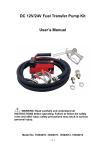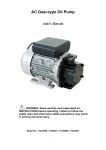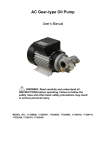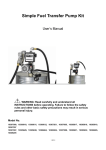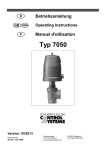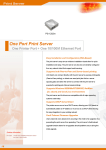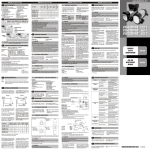Download DC Oil Transfer Pump User's Manual
Transcript
DC Oil Transfer Pump User’s Manual WARNING Read carefully and understand all INSTRUCTIONS before operating. Failure to follow the safety rules and other basic safety precautions may result in serious personal injury. Save these instructions in a safe place and on hand so that they can be read when required. Model No.: 17520100, 17520101, 17520102, 17520103 A. DECLARATION OF CONFORMITY DECLARATION OF CONFORMITY IN CONFORMANCE WITH THE DIRECTIVES 98/37/EEC (MACHINERY) 73/23/EEC (PRESSURE VESSELS) 89/336/EEC (ELECTOR-MAGNETIC COMPATIBILITY) THE MANUFACTURER INTRADIN (SHANGHAI) MACHINERY 118 DUHUI ROAD, MINHANG DISTRICT, SHANGHAI, 201109 CHINA DECLARES THAT THE FOLLOWING PUMP MODELS: 17520100, 17520101, 17520102, 17520103 CONFORMS TO THE FOLLOWING EUROPEAN REGULATIONS: EN292-1-92 – Safety of Machinery – General Concepts, basic principles for design – terminology, basic methodology EN292-2-92 – Safety of Machinery – General Concepts, basic principles for design – specifications and technical principles EN294-93 – Safety of Machinery – safe distances to prevent the operator’s upper limbs from reaching dangerous areas EN60034-1-2000 – Rotating electrical Machinery – nominal and functional specifications EN60034-5-2001 – Classification of grades of protection for the housings of rotating electrical machinery EN61000-6-3 – Electro – magnetic compatibility – generic emission standards EN61000-6-1 – Electro – magnetic compatibility – generic immunity standards EN55014-1-00(A1/99-A2/99) –Limits and methods for measuring radio disturbance characteristics EN55014-2-97 – Electrical motor – operated and thermal appliances for household and similar purposes, electric tools and similar electrical apparatus EN60204-1-98 –Safety of machinery – electrical equipment of machines B. MACHINE DESCRIPTION Pump: Electric self-priming rotary external gear pump, equipped with a by pass valve MOTOR: Brush motor powered by continuous current, low voltage, with intermittent cycle, closed type, IP55 protection class according to CEI EN 60034-5. C. TECHNICAL INFORMATION Description Europe America 17520100 17520101 17520102 17520103 Voltage 12V 24V 12V 24V Power 150W 150W 150W 150W Current 40A 30A 40A 30A Flow Rate 10LPM 10LPM 10Quarts/min. 10Quarts/min. Pressure 4 bar 4 bar 60 PSI 60 PSI Inlet/Outlet 3/4” BSP 3/4” BSP 3/4” NPT 3/4” NPT Rated Speed 2900 RPM 2900 RPM 2900 RPM 2900 RPM D. OPERATING CONDITIONS D.1 ENVIRONMENTAL CONDITIONS Temperature: min-10°C/max+60°C Relative humidity: max. 90% ATTENTION! The temperature limits indicated are applied to the pump components and must be respected to avoid possible damage or malfunction. It is understood, nevertheless, that for a given oil, the real functioning temperature range also depends on the variability of the viscosity of the oil itself with the temperature. Specifically: z The minimum temperature allowed -10℃) could cause the viscosity of some oils to greatly exceed the maximum allowed, with the consequence that the static torque required during the starting of the pump would be excessive, risking overload and damage to the pump. z The maximum temperature allowed (+60℃) could, on the other hand, cause the viscosity of some oils to drop well below the minimum allowed, causing a degradation in performance with obvious reductions in flow rate as the back pressure increases. D.2 ELECTRICAL POWER SUPPLY Depending on the model, the pump must be supplied by a continuous current line whose nominal values are shown in the table in Paragraph C-TECHNICAL INFORMATION. The maximum acceptable variations from the electrical parameters are: Voltage: +/-5%of the nominal value ATTENTION! Power from lines with values outside of the indicated limits can damage the electrical components. D.3 WORKING CYCLE The pumps are designed for INTERMITTENT use with a 30-minute work cycle under conditions of maximum back pressure ATTENTION! Functioning under by-pass conditions I only allowed for brief periods of time(2-3minutes maximum).after a work cycle of 30 minutes, wait for the motor to cool. D.4 FLUID ALLOWED/FLUID NOT ALLOWED ALLOWED: Oil with a Viscosity from 50 to 600cst (at working temperature) NOT ALLOWED RELATED DANGER Gasoline (Petrol) Fire - explosion Inflammable liquids with PM < 55℃ Fire - explosion Water Oxidation of the pump Liquid food products Contamination of same Corrosive Chemicals Corrosion of the pump Injury to people Solvents Fire – explosion Damage to gasket seals E. MOVING AND TRANSPORTING Given the limited weight and size of the pumps (See dimensions and weights), moving the pumps does not require the use of lifting equipment. The pumps are carefully packed before shipment. On receipt, check the packing materials and store in a dry place. F. INSTALLATION F.1 Preliminary Inspection z Check that the machine has not suffered any damage during its transport or warehousing. z Clean the inlet and outlet openings with care, removing any dust or packing residue. z Make sure that the motor shaft turns freely. z Check that the electrical information corresponds with what is shown on the label. F.2 MECHANICAL INSTALLATION The pumps can be installed as follows: a) Horizontally b)To the wall With pump body up wards c) To the wall. With pump body aside only with check valve installed d) To the wall With check valve installed It is recommended to install a check valve in order to resume the system operation quickly and easily even after the first priming ATTENTION! Under conditions C and D, a check valve is to be installed. Moreover, during the initial start-up phase, the suction tube is to be filled with oil. Fix the pump using screws of a diameter suitable for the provided fixing holes as indicated in the drawing “Dimensions and weights”. ATTENTION! THE MOTORS ARE NOT OF AN ANTI-EXPLOSIVE TYPE Do not install them where inflammable vapours could be present. ATTENTION! It is the installer’s responsibility to provide the line accessories necessary for the safe and proper functioning of the pump. The use of accessories that are inappropriate for use with oil can cause damage to the pump or people as well as pollution G. INITIAL START-UP The pumps are self-priming and, therefore, able to draw oil from the tank even when the suction hose is empty on start-up. The priming height (distance between the surface of the oil and the inlet opening) must not exceed 2.5 meters ATTENTION! Wetting the pump. Before starting the pump, wet the inside of the pump body with oil through the inlet and outlet openings. If the pump is already installed, the operation can be performed by removing the cover of the chamber filling the internal chamber with oil and placing the cover again, paying attention to the O-ring seal. In the priming phase the pump must blow the air that was initially present in the tubing into the line, therefore, it is necessary to keep the delivery open. When the tube is filled with oil, the purging phase is concluded. ATTENTION! If a foot valve was not installed, install the pump in a position so that oil is always present in the gear chamber. If the foot-valve seal is not perfectly tight, the suction tube may be emptied and the operation of initial start-up described above must be repeated. The priming phase may last from several seconds to a few minutes, depending on the characteristics of the system. If this phase is excessively prolonged, stop the pump and verify: z That the pump is not running completely ”dry” z That the suction hose guarantees against air infiltration and is correctly immersed in the fluid to be drawn z That the filter in the suction circuit, if any, is nit blocked z That the delivery hose allows for the easy evacuation of the air z That the priming height is not greater than 2.5 meters z The exact rotation direction of the motor: it must be in a counter-clockwise considering the motor from pos. 1 of the exploded diagram. When priming has occurred, after reattaching the delivery nozzle, verify that the pump is functioning within the expected ranges, possibly checking: that under conditions of maximum flow the energy drawn by the motor falls within the values indicated on the label H. DAILY USE NO particular preliminary operation is required for every day use of these pumps. z Before starting the pump, make sure that the ultimate shut-off device (delivery nozzle or line valve) is closed. If the delivery has no shut-off device (free delivery), make sure that it is correctly positioned and appropriately attached to the delivery tank. z Make sure that the tank is filled with a quantity of oil greater than the quantity to be supplied (running dry could damage the pump) z Turn the on-switch present on some pump models or the start/stop switch installed on the electrical power line z Open the delivery valve or activate the delivery nozzle, gripping it securely ATTENTION! Fluid exits at high pressure from a delivery nozzle fed by the pump. Never point the outlet of the nozzle towards any part of the body. Close the delivery nozzle or the line valve to stop delivery .the pump will automatically enter by-pass mode. ATTENTION! Functioning with the delivery closed is only allowed for brief periods (2 to 3minutes maximum). functioning under nominal conditions in limited to a work cycle of 30 minutes. If this time is exceeded, you have to run off the pump and wait for it to cool after use, make sure the pump us turned off. Stop the pump. I. PROBLEMS AND SOLUTIONS PROBLEM POSSIBLE CAUSE CORRECTIVE ACTION Motor does not turn Lack of electric power Check electrical connections and the safety systems Rotor jammed Check for possible damage or obstruction of the rotating components Motor problems Contact the service department Fuse burnt out Replace the fuse Low voltage from the electrical power supply Adjust the voltage within anticipated limits Excessive oil viscosity Verify oil temperature and warm it to reduce excessive viscosity Low level in the suction tank Fill in the tank Foot valve blocked Clean and/or replace valve Filter blocked Clean the filter Excessive suction pressure Lower the pump with respect to the level of the tank or increase the cross-section of the hose High load loss in the delivery circuit (running with by-pass open) Use shorter hose or of wider diameter By-pass valve blocked Detach the valve, clean or replace it Air in the pump or suction hose Check the seal of the connection Narrowing of the suction hose Use a hose appropriate for working under suction pressure Low rotation speed Check the voltage at the pump. Adjust the voltage or use cables of greater cross-section Excessive oil viscosity Verify the oil temperature and warm it to reduce the excessive viscosity Motor turns slowly when starting LITTLE OR NO FLOW HIGHER PUMP NOISE LEAKAGE FROM THE PUMP BODY HIGH ABSORPTION Cavitations Reduce the suction pressure Irregular by-pass functioning Deliver until the air in the by-pass system is purged Presence of the air in the oil Wait for the oil in the tank to settle Damage to the mechanical seal Check and replace the mechanical seal The cover is screwed too tightly Loosen the screws of the cover Excessive oil viscosity Verify the oil temperature and warm it to reduce the excessive viscosity J. MAINTENANCE z z z z On a weekly basis check that the hose joints have not loosened, to avoid any leakage On a monthly basis check the pump body and clean it removing any impurities. On a monthly basis check and clean the filters placed at the pump inlet. On a monthly basis check that the electric power cables are in good condition. K. NOISE LEVEL Under Normal operating conditions noise emission for all models does not exceed the value of 70 db “A” at a distance of 1 Meter from the electric pump. L. EXPLODED DIAGRAMS AND SPARE PARTS o. Description Qty 1 SCREW M6x10 4 2 Gear coverplate 1 3 O-RING 58.42x2.62 1 4 Driver key 1 5 Gear 2 6 Axile bush 2 7 Pump body 1 8 Oil seal 1 9 elastic collar 1 10 ball bearing 1 11 Motor 1 12 SCREW M5X10 2 13 bracket 1 14 Valve plug 2 15 O-RING 11.1*1.78 2 16 compression helical spring 1 17 by-pass valve 1








